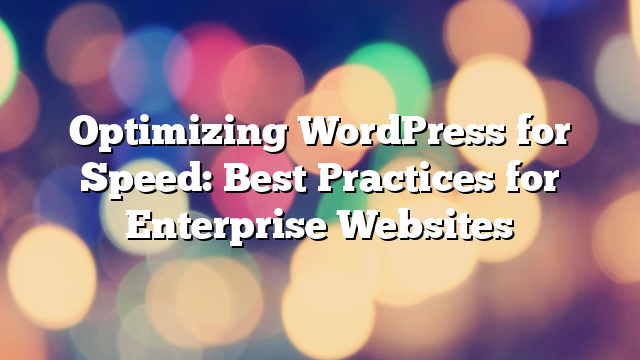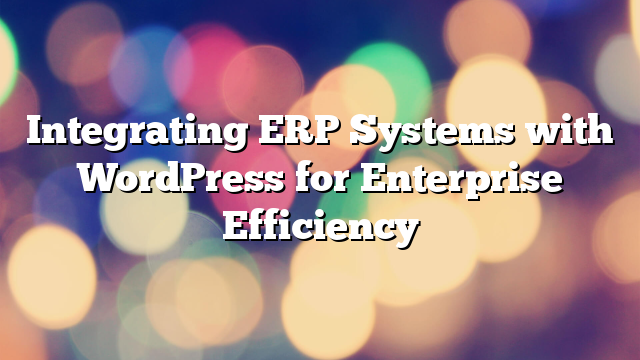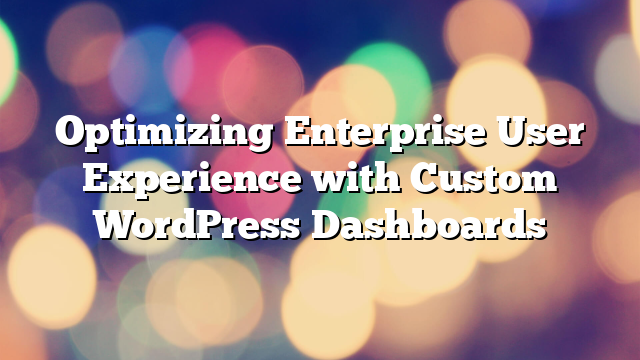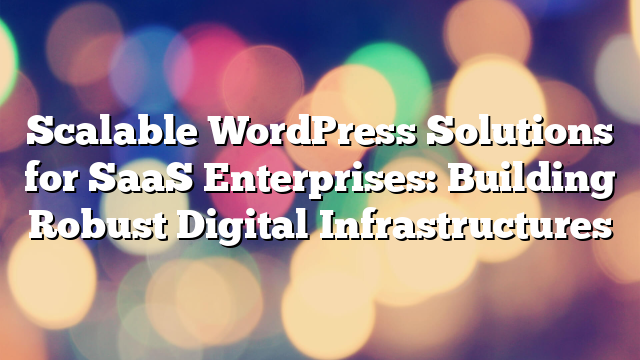Optimizing WordPress for Speed: Best Practices for Enterprise Websites
05.05.2025

In the fast-paced world of digital business, speed is a critical factor that affects user experience, SEO rankings, and conversion rates. For enterprise-level websites, optimizing WordPress for performance can make a significant impact on how your site is perceived and how it performs under heavy traffic loads. This article discusses best practices for optimizing WordPress websites, ensuring fast load times and seamless performance across all devices.
Why Speed Matters for Enterprise Websites
Website speed is more than just a convenience — it’s a vital aspect of user experience and search engine optimization (SEO). Slow websites frustrate users and lead to higher bounce rates, negatively affecting conversion rates. Furthermore, Google uses page speed as a ranking factor, meaning a slow website could hurt your SEO performance.
For enterprise websites, which often have large-scale content and high traffic volumes, speed optimization is even more crucial. With the right optimizations in place, businesses can offer a smoother experience for visitors, even during peak traffic periods.
Best Practices for Optimizing WordPress for Speed
1. Choose the Right Hosting Provider
The foundation of a fast WordPress site starts with reliable hosting. Enterprise-level websites require a robust hosting infrastructure that can handle high volumes of traffic without slowing down. Managed WordPress hosting providers like WP Engine, SiteGround, or Kinsta offer optimized environments tailored specifically for WordPress, with fast servers, enhanced security, and server-side caching.
2. Use a Content Delivery Network (CDN)
A Content Delivery Network (CDN) stores copies of your site’s static content (such as images, CSS, and JavaScript files) on multiple servers worldwide. When a user visits your website, the CDN serves the content from the server nearest to them, reducing latency and improving load times. Popular CDN providers include Cloudflare, MaxCDN, and Akamai.
3. Optimize Images and Media Files
Large images can significantly slow down page load times. Optimizing images by reducing their file size without sacrificing quality is crucial. Tools like Smush or Imagify automatically compress and optimize images for faster load times. Additionally, consider using modern image formats like WebP, which offer better compression than traditional formats like JPG or PNG.
4. Minimize HTTP Requests
Each element on a page (such as images, scripts, stylesheets, and fonts) requires an HTTP request, which can add to the load time. To speed up your site, reduce the number of elements on each page by minimizing the use of heavy elements and unnecessary external resources. Tools like Autoptimize and WP Rocket can help combine and minimize CSS, JavaScript, and HTML files, reducing the number of HTTP requests needed to render a page.
5. Enable Caching
Caching allows you to store static versions of your pages and serve them to users without requiring WordPress to dynamically generate each page on every visit. By implementing both browser caching and server-side caching, you can drastically improve load times. Plugins like WP Super Cache or W3 Total Cache can help implement caching for your site.
6. Optimize Database Performance
Over time, your WordPress database accumulates unnecessary data, such as old post revisions, trashed posts, and unused metadata. These can slow down queries and affect performance. Regular database optimization is essential for maintaining speed. Plugins like WP-Optimize or Advanced Database Cleaner can help clean and optimize your database, removing unnecessary data and improving database performance.
7. Use Lightweight Themes and Plugins
Choosing a well-coded, lightweight theme is essential for speed optimization. Many themes come with bloated code, excessive features, and unoptimized assets, which can slow down your site. Opt for themes that are built with performance in mind, like Astra or GeneratePress.
Similarly, the plugins you install on your WordPress site can impact performance. Avoid using too many plugins, and make sure to disable or remove any that are not essential. Opt for lightweight plugins that don’t load unnecessary resources. Always choose reputable plugins that follow best coding practices.
8. Enable GZIP Compression
GZIP compression reduces the size of your website’s files, including HTML, CSS, and JavaScript, before sending them to the browser. This can significantly reduce the amount of time it takes for your site to load. Most managed hosting providers enable GZIP by default, but if your hosting doesn’t support it, you can enable it manually through your .htaccess file or using a plugin like WP Rocket.
9. Use Lazy Loading for Images and Videos
Lazy loading is a technique that only loads images and videos as the user scrolls down the page. This prevents all media from being loaded at once, improving initial page load times. WordPress introduced built-in lazy loading for images in version 5.5, but you can also implement advanced lazy loading for videos and iframes using plugins like Lazy Load by WP Rocket or a3 Lazy Load.
10. Keep WordPress, Themes, and Plugins Updated
Regular updates are essential not only for security but also for performance. Developers often release updates to improve the performance of themes, plugins, and WordPress itself. Keeping everything up to date ensures that you benefit from the latest performance enhancements and bug fixes, which can improve your site’s speed over time.
Essential Tools for Performance Monitoring
To track the effectiveness of your speed optimization efforts, it’s essential to monitor the performance of your website regularly. Here are some top tools for performance monitoring:
- Google PageSpeed Insights: Provides detailed insights into your website’s performance on mobile and desktop devices, along with suggestions for improvements.
- GTmetrix: A comprehensive tool for analyzing your website’s speed, including detailed reports on page load times, recommendations, and performance scores.
- Pingdom: Offers performance testing and uptime monitoring, helping you track your site’s speed from different locations worldwide.
Conclusion: Speed Optimization for a Competitive Edge
Optimizing your WordPress website for speed is essential for improving user experience, boosting SEO, and increasing conversion rates. By following the best practices outlined in this article, enterprise websites can ensure fast load times, even under heavy traffic. Whether you’re working with a global audience or a niche market, site speed should always be a priority to maintain competitiveness and customer satisfaction.
If you’re looking for professional WordPress optimization services to speed up your enterprise site, Vipe Studio can help with tailored solutions that meet your specific performance needs.



